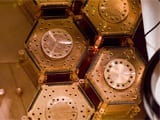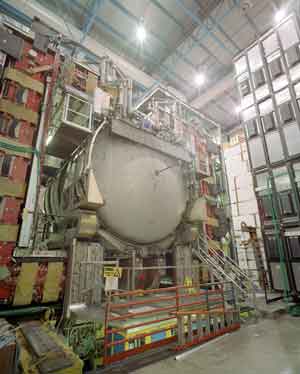 A scientific group of experimental particle physicists have reported in the latest issue of the journal Science that they cannot rule out that they may have seen a glimpse of dark matter.
A scientific group of experimental particle physicists have reported in the latest issue of the journal Science that they cannot rule out that they may have seen a glimpse of dark matter.
Physicists have been searching for dark matter — the substance that makes up most of the matter in the universe — for decades. Jodi Cooley, an assistant professor of experimental particle physics in the SMU Physics Department, is a member of the collaboration on the Cryogenic Dark Matter Search (CDMS II) experiment.
The experiment is located deep in the Soudan Underground Laboratory in an abandoned mine in a national park in Minnesota.
BBC News reported on the published results in a Feb. 11 article “Study hints at dark matter action” by the BBC’s science reporter Doreen Walton and published to the BBC News web site.
Cooley, quoted in the BBC article, said “Either we had a statistical fluctuation in our background or it could be that these two events are evidence of dark matter but there weren’t enough of them to be sure.”
Excerpt:
By Doreen Walton
BBC News
Researchers in the U.S. say they have detected two signals which could possibly indicate the presence of particles of dark matter.But the study in Science journal reports the statistical likelihood of a detection of dark matter as 23 percent.
Deep underground in a lab in Minnesota experiments to detect WIMPS, or Weakly Interacting Massive Particles have been going on since 2003. Scientists are currently developing an even more sensitive experiment.
“It’s a very difficult situation,” said Professor Jodi Cooley from Southern Methodist University, Dallas in the U.S., who led the research. “In some ways I feel we’ve been very unlucky.
“Either we had a statistical fluctuation in our background or it could be that these two events are evidence of dark matter but there weren’t enough of them to be sure. We can’t rule them out as being a signal but we can’t conclude that they are a signal.”
Read “Study hints at dark matter action“
The scientific findings were published in the journal Science on Feb. 11, “Dark Matter Search Results from the CDMS II Experiment.”
Excerpt:
Astrophysical observations indicate that dark matter constitutes most of the mass in our universe, but its nature remains unknown. Over the past decade, the Cryogenic Dark Matter Search (CDMS II) experiment has provided world-leading sensitivity for the direct detection of Weakly Interacting Massive Particle (WIMP) dark matter. The final exposure of our low-temperature Ge particle detectors at the Soudan Underground Laboratory yielded two candidate events, with an expected background of 0.9 – 0.2 events. This is not statistically significant evidence for a WIMP signal.
Click to read the full abstract.
Cooley and her colleagues earlier announced the groundbreaking CDMS findings at dual press conferences on Dec. 17. The team, known as the Cryogenic Dark Matter Search, hosted simultaneous talks by Cooley at the SLAC National Acceleratory Laboratory in California and by Lauren Hsu of the Fermi National Accelerator Laboratory in Illinois at Fermilab.
Scientists of the Cryogenic Dark Matter Search experiment are listening for whispers of dark matter. Inspired by his brother Erik’s research, musician Karl Ramberg built a musical model of the CDMS detector, in collaboration with CDMS scientists. Erik Ramberg and Priscilla Cushman translated real CDMS data into a format that accurately converts the energy, location and type of particles striking the CDMS detectors into sound and light. Cushman created this 5-minute video.
Related links:
CDMS: Lay explanation of the research findings
Video: Jodi Cooley at SLAC
Symmetry Magazine: Dark Matter Experiment Results Announced
Fermilab: Dark matter and supersymmetry FAQ
Fermilab images: Cryogenic Dark Matter Search
Fermi National Accelerator Laboratory
Nobel Prize: Why is there something instead of nothing?


